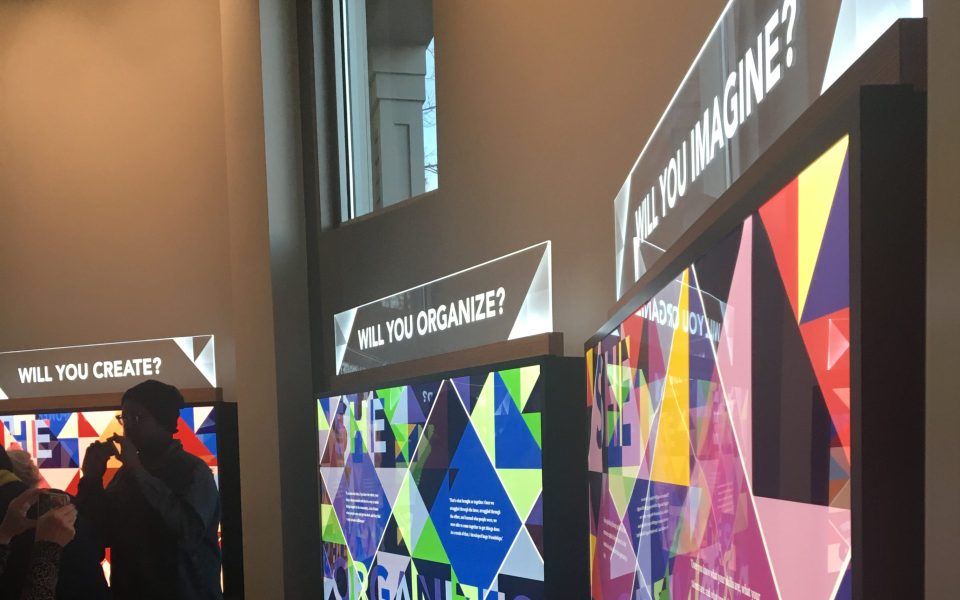A small girl peeks her head over a table. A digital screen blankets the table top, and on it appears a small, off-white box with blue and purple triangles reaching out from each side. She reaches over and taps the box, which unfolds like a paper fortune teller.
But rather than telling the future, these panels tell the past and present.
The Greensboro Parks and Recreation Department opened the Ruth Wicker Tribute to Women, an exhibit housed in the new Barber Park Event Center, on Friday. The upscale space offers an additional venue in East Greensboro’s Barber Park, and houses the show which highlights women who have helped the city grow.
Planning and Project Development Division Manager Shawna Tillery explained the decade-long process that parks and rec underwent to create the facility. Ruth Wicker donated a sum of $900,000 to help the city construct the exhibit upon her passing in 2008. The city added approximately $2.1 million to expand the center, and chose Barber Park as the location. Architect Shermin Ata used concept plans from John Wicker — Ruth’s late husband who designed the Greensboro Coliseum — to create its design.
“She based her design on Mr. Wicker’s original design for the building,” Tillary said. “So the whole building itself kind of has that Wicker touch to it.”
The structure rests in an opening in the woods, with trails tangling around the building. A roofed corridor juts out from the brick and tan slats in front and invites people inside, while windows cover most of the building’s rear.

Inside the first room, colorful triangles surround wall displays, each with information on local community organizations like the Women’s Resource Center of Greensboro or Neighborhood Congress.
With no restrictions on whom to honor, the department invited people from the community to nominate women for the exhibit. After several months of group meetings between city staff, community members and members of the Greensboro Commission on the Status of Women, a total of 31 women, all with different careers, found their names in the Ruth Wicker tribute, along with four organizations.
“There’s not really any focused, women-only exhibit in the state,” Tillary said, “and only a few in the country that are solely dedicated to the contributions of women.”
Questions written in white, lit-up script welcome visitors into the next room, asking, “Will you inspire?” or “Will you imagine?” to those who enter the room. A crowd surrounds a table-top screen, tapping on stars with women’s names to learn more about them. A man views a short biography about musician Rhiannon Giddens, while the woman beside him reads about news anchor Sandra Hughes. A couple presses a red star on the screen to view a photo of athletics director Aggie “Jean” Jackson, while another visitor taps on a different triangle, turning it yellow as it shows a quote from former Greensboro police Capt. Pam McAdoo-Rogers.
“I think it’s important for people to see that you can contribute to your community in various ways,” Tillary said. “You don’t have to be a prominent political figure in order to contribute to your community.”
Like many of the women featured in the tribute, Ruth Wicker influenced her community by following her interests. Wicker involved herself in multiple clubs, including the Greensboro Council of Garden Clubs. She also worked with the Daughters of the American Revolution and studied family genealogy, while also being involved in the Christ United Methodist Church.
Prior to the ribbon cutting on Friday, Wicker’s niece, Mary Susan Caldwell Wilkie, told of her aunt’s rich life, including a fund Wicker set up for lectures at the Greensboro History Museum, and the nursing scholarship set up at UNCG to commemorate her late sister — Wilkie’s mother.
“She knew what she wanted,” Wilkie said. “And she went for it.”
Join the First Amendment Society, a membership that goes directly to funding TCB‘s newsroom.
We believe that reporting can save the world.
The TCB First Amendment Society recognizes the vital role of a free, unfettered press with a bundling of local experiences designed to build community, and unique engagements with our newsroom that will help you understand, and shape, local journalism’s critical role in uplifting the people in our cities.
All revenue goes directly into the newsroom as reporters’ salaries and freelance commissions.


Leave a Reply